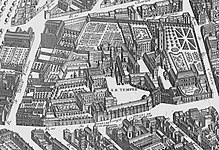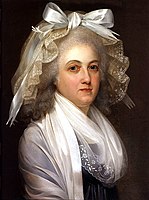Square du Temple
This article may be expanded with text translated from the corresponding article in French. (August 2015) Click [show] for important translation instructions.
|
| The Paris Temple | |
|---|---|
| Paris, France | |
 A view of the Grosse Tour-circa 1795, Ecole Française 18th century. | |
 The Paris Temple | |
| Type | Medieval fortress |
| Site information | |
| Condition | Demolished |
| Site history | |
| Built | mid-13th century |
| Built by | Knights Templar |
| Demolished | 1808 |
| Events | French Revolution |

The Temple area in 1734 - detail of the Turgot map of Paris.
The Square du Temple is a garden in Paris, France in the 3rd arrondissement, established in 1857. It is one of 24 city squares planned and created by Georges-Eugène Haussmann and Jean-Charles Alphand. The Square occupies the site of a medieval fortress in Paris, built by the Knights Templar. Parts of the fortress were later used as a prison during the French Revolution, and then demolished by the mid 19th century.
Contents
1 History
1.1 Knights Templar
1.2 French Revolution
1.3 Demolition
2 Today
3 In literature
4 References
5 External links
History
Knights Templar
The Knights Templar actually began in the 12th century, constructing a fort first (Vieux Temple or Old Temple) in Le Marais. In the 13th century, a new fortress was built as their European headquarters. The enclosure, called enclos du Temple, originally featured a number of buildings important to the running of the Order, and included a church and a massive turreted keep known as Grosse Tour (great tower), and a smaller tower called Tour de César (Caesar's Tower).
The location of the towers is drawn on the floor in front of the town hall,[1] rue Eugene Spuller. The heavy doors of the Grosse Tour still exist and are kept at Château de Vincennes whose great keep, attributed to Raymond du Temple, is speculated to have been inspired by the nearby Templar fortress.[2]
French Revolution
The Temple is also known for having been the place where the French royal family was jailed at the time of the Revolution. Members of the royal family imprisoned at the Temple's tower were:
King Louis XVI, from 13 August 1792 to 21 January 1793, when he was taken to be guillotined at the Place de la Révolution;
Marie Antoinette, from 13 August 1792 to 1 August 1793 in the Temple's tower. She was then brought to the Conciergerie, from where she eventually was also taken to the guillotine;
Madame Élisabeth, who stayed for 21 months at the tower before being taken on 9 May 1794 to the Conciergerie and guillotined the following day;
Louis XVII, from 13 August 1792 until his death of tuberculosis at the tower on 8 June 1795, at the age of ten;
Princess Marie-Thérèse, who stayed at the tower for three years and four months before being sent into exile.
Demolition
By 1808, the Temple had become a place of pilgrimage for royalists, so Napoleon ordered its demolition, which took two years. Remnants were demolished around 1860 under orders from Napoleon III.
Today
Today its location is a station of the Paris Metro, serving the carreau du temple (covered market) and the Palais de Justice (Courthouse) of the third arrondissement.
The garden includes a gazebo, a playground for children, lawns with the largest open to the public from April 15 to October 15, fountains and a pond with an artificial waterfall, on rocks from the forest of Fontainebleau. The grid surrounding the square was designed by the architect Gabriel Davioud. The square contains almost 200 varieties of plants, including many exotic species, such as hazel, a Ginkgo biloba, a Honey Locust of America, a ptérocaryer Caucasus, goldenrain tree, Cedrela, and Chinese quince.
In 2007, the square has been awarded the "ecological green spaces" awarded by ECOCERT, the international organic certification.
There are two statues. One represents the songwriter Pierre-Jean de Béranger, who lived on the nearby street, which later took his name. This is the second in his image: a first bronze statue, due to Amédée Doublemard was erected by public subscription opened in 1879 by the newspaper La Chanson and destroyed in 1941. It was replaced in 1953 by the present statue in stone, Henri Lagriffoul.
Another statue is made of a bust on a pedestal, which is registered "At B. Wilhelm founder 1781-1842 The Orphéon French", above a medallion portrait and the text" To Eugene Delaporte propagator 1818-1886 ".
On 26 October 2007, a monument was inaugurated on the lawn of the main square of the Temple. It carries the names and ages of 85 "little ones who do not have time to attend school," Jewish children from 2 months to 6 years living in the 3rd arrondissement and deported between 1942 and 1944 and then murdered in Auschwitz. This monument was unveiled in the presence of several hundred people, the elect of the district and the city and representatives of associations, the Sons and Daughters of Jewish Deportees from France. The memorial is one of several honoring the 11,400 Jewish children deported from France. The lists of children were compiled from school and civic records by Serge Klarsfeld.

Surviving doors from the Grosse Tour, now found in the Château de Vincennes
In literature
- In Patrick O'Brian's Aubrey/Maturin series, Jack Aubrey, Stephen Maturin and a young Lithuanian soldier, Jagiello, are held prisoner at the Temple Prison during its demolition in The Surgeon's Mate.
- The Temple in art

Miniature from the Hours of Étienne Chevalier with the Temple in the background

Louis XVI at the Tour du Temple, by Jean-François Garneray (1755-1837).

Marie Antoinette, in the Temple Tower, attributed to Kucharsky
References
^ "Google Maps"..mw-parser-output cite.citation{font-style:inherit}.mw-parser-output q{quotes:"""""""'""'"}.mw-parser-output code.cs1-code{color:inherit;background:inherit;border:inherit;padding:inherit}.mw-parser-output .cs1-lock-free a{background:url("//upload.wikimedia.org/wikipedia/commons/thumb/6/65/Lock-green.svg/9px-Lock-green.svg.png")no-repeat;background-position:right .1em center}.mw-parser-output .cs1-lock-limited a,.mw-parser-output .cs1-lock-registration a{background:url("//upload.wikimedia.org/wikipedia/commons/thumb/d/d6/Lock-gray-alt-2.svg/9px-Lock-gray-alt-2.svg.png")no-repeat;background-position:right .1em center}.mw-parser-output .cs1-lock-subscription a{background:url("//upload.wikimedia.org/wikipedia/commons/thumb/a/aa/Lock-red-alt-2.svg/9px-Lock-red-alt-2.svg.png")no-repeat;background-position:right .1em center}.mw-parser-output .cs1-subscription,.mw-parser-output .cs1-registration{color:#555}.mw-parser-output .cs1-subscription span,.mw-parser-output .cs1-registration span{border-bottom:1px dotted;cursor:help}.mw-parser-output .cs1-hidden-error{display:none;font-size:100%}.mw-parser-output .cs1-visible-error{font-size:100%}.mw-parser-output .cs1-subscription,.mw-parser-output .cs1-registration,.mw-parser-output .cs1-format{font-size:95%}.mw-parser-output .cs1-kern-left,.mw-parser-output .cs1-kern-wl-left{padding-left:0.2em}.mw-parser-output .cs1-kern-right,.mw-parser-output .cs1-kern-wl-right{padding-right:0.2em}
^ Lorentz, Phillipe; Dany Sandron (2006). Atlas de Paris au Moyen Âge. Paris: Parigramme. p. 238 pp. ISBN 2-84096-402-3.
External links
![]() Media related to Temple (Paris) at Wikimedia Commons
Media related to Temple (Paris) at Wikimedia Commons
Coordinates: 48°51′55″N 2°21′44″E / 48.86528°N 2.36222°E / 48.86528; 2.36222


